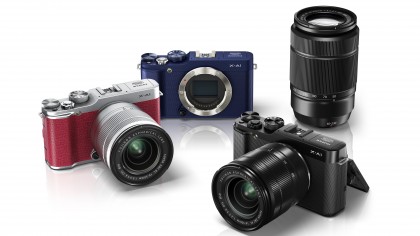TechRadar Verdict
The X-A1 scores well for build and functionality and price, which makes the slight dip in image quality in comparison with the Fuji X-M1 palatable. It also provides a step into Fuji's X-system, which has a growing collection of lenses.
Pros
- +
Most affordable Fuji CSC
- +
Natural, vibrant images
- +
Tilting LCD
Cons
- -
No viewfinder
- -
Screen not touch-sensitive
- -
Standard sesnor
Why you can trust TechRadar
The Fuji X-A1 is the fourth model in the company's X-series of compact system cameras, but it is identical to the Fuji X-M1 in all but one vital way - the sensor. Whereas the Fuji X-M1 has the same APS-C format X-Trans CMOS sensor as the Fuji X-Pro 1 and Fuji X-E1, the X-A1 has an APS-C format CMOS sensor with a Bayer pattern primary colour filter.
While the X-Trans sensor's random colour filter arrangements means it doesn't require an optical low pass filter, the more standard Bayer pattern filter over X-A1's sensor does. This is likely to mean that the 16.3 million pixel sensor of the X-A1 isn't able to resolve quite as much sharp detail as the 16.3 million pixel sensor in Fuji's other cameras. However, we've been happy with Bayer patterns in digital cameras for years, so it may not be a major issue.

The change to a more common sensor design enables Fuji to offer X-A1 at a more affordable price than the X-M1; with the X-A1 retailing for around US$599/£499 with the 16-50mm f/3.5-5.6 kit lens and the X-M1 retailing for around US$799/£679 with the same optic.
Features
Fuji has coupled the X-A1's sensor with its EXR Processor II, the same processing engine as in the X-M1, and this enables the X-A1 to shoot up at up to 5.6fps (frames per second) for up to 30 JPEG or 10 raw (or raw & JPEG) files. It also allows sensitivity to be set in a native range of ISO 200-6400, but there are expansion settings of ISO 100, 12800 and 25600 available when shooting JPEGs.
As we would expect with a camera in Fuji's X-series, images may be saved to the SD/SDHC/SDXC card as raw or JPEG files, or both simultaneously. There are also five Film Simulation modes – Provia (standard), Velvia (vivid), Astia (muted), Sepia and Black-and-White – with which to tailor the look of the JPEG images.
While these modes may be used when shooting raw files simultaneously, the Advanced Filter options (Toy Camera, Miniature, Dynamic Tone, Pop Colour, Soft Focus, High Key, Low Key and Partial Colour) are JPEG-only. This is a shame, as it means you can't retain a 'clean' raw image for post-capture processing alongside the JPEG with the filter applied.

Fuji provides an unusual array of bracketing options including Auto Exposure (±1/3EV/±2/3EV/±1EV), Film Simulation mode (three user-selectable options), Dynamic Range (100%, 200% and 400%) and Sensitivity (±1/3EV/±2/3EV/±1EV), so there are plenty of options for the indecisive as well as in tricky lighting conditions.
Sign up for breaking news, reviews, opinion, top tech deals, and more.
In common with the majority of recently announced cameras, the X-A1 has Wi-Fi connectivity built-in. This enables images to be transferred wirelessly to a smartphone or tablet via Fujifilm's free app, and from there they can be shared on Facebook and Twitter etc. The camera can also use Geotagging data from a smartphone to tag an image.
Fuji also provides its free PC AutoSave software ( for Windows and Mac) for transferring images wirelessly to a computer. Once the camera has been paired with your Wi-Fi router it's just a question of selecting the folder to which the images will be saved. From then on, images should be saved automatically once a wireless connection is established.

Like the X-M1, the X-A1 doesn't have a viewfinder built-in, but there is a three-inch 920,000-LCD screen mounted on a tilting bracket which offers a view of around 100% of the frame. This is only the second time that Fuji has used a tilting screen, with the first being on the X-M1.
As usual with a compact system camera, the Fuji X-A1 uses a contrast detection autofocus (AF) system. This has 49 points which may be selected individually by the photographer, or the choice can be left to the camera in Multi AF mode. These options are backed-up by Tracking AF and Continuous AF modes for use with moving subjects and manual focus mode for when the need arises.
Although the X-A1 has a small pop-up flash unit built-in (Guide Number 7 at ISO 100), there's a hotshoe for mounting an external flashgun for those times when more powerful illumination is required.
